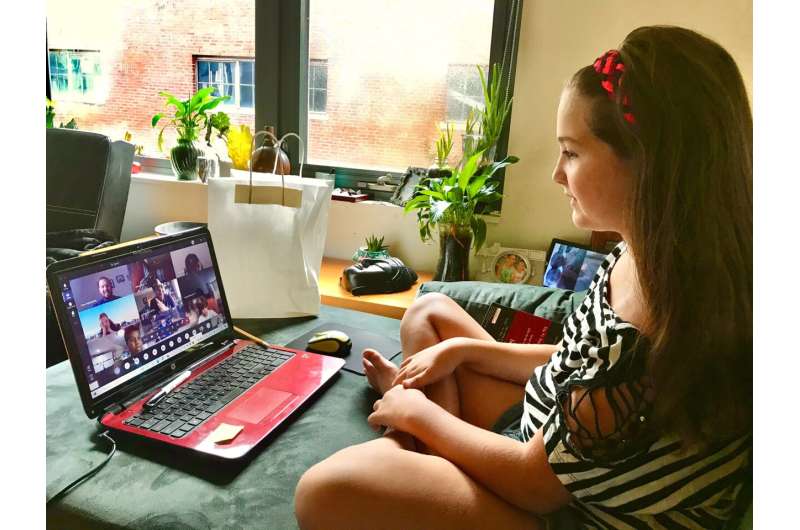
Social media plays an important role in the lives of many tweens and teens. More than one-third (35%) of 13- to 17-year-olds reported using social media sites such as YouTube, TikTok, Instagram, Snapchat and Facebook “almost constantly” in 2022. And while many social media platforms set a minimum age of 13 to sign up, 38% of kids ages 8-12 say they have used social media.
All this media use can influence young people in a variety of ways. And with a reported rise in depression and anxiety among teens, you may wonder how social media may impact your child’s mental health. Research suggests it depends on how they use it. Understanding potential connections between social media and mental health can help you guide your kids toward healthy social media habits.
One of the ways kids use social media is for social connection. Sharing photos and comments on social media platforms can help keep them in touch with peers and family who live far away, for example. Teens can also join groups that represent aspects of their identities or interests, such as groups around sports, theater, music or LGBTQ pride and support.
Another positive way adolescents use social media is to learn. They can explore and follow organizations such as art museums, local park systems or recipe bloggers. Some platforms also allow them to create and share their own content. Adolescents have described sharing their own crafts, hobbies and art to their social media audiences.
Using social media too much, though, can push out other important activities. Examples include being in person with friends and family or getting enough sleep.
Social media can also expose adolescents to content that is violent, dangerous or inaccurate. Further, social media can present idealized images of people that can lead to issues with body image for some teens.
There have been a lot of news stories lately about whether too much social media use contributes to depression. Some studies have found that young people who used more social media were more likely to report depression symptoms. It is important to consider that these studies could not tell if more social media use was impacting depression, or whether participants with depression already were using more social media. The cause-and-effect relationship for social media and depression remains unclear.
There are also research studies that found no relationship between the amount of social media use and depression symptoms. In a few other studies, researchers found that there was a small effect on depression, but only with very high levels of social media use.
All of these studies focus on the quantity of social media use; they do not address the different ways that each unique child may use social media.
Another important consideration about social media and mental health is how your child uses social media.
Some studies show that teens who use social media in a passive way, such as by scrolling and looking at content as it goes by on the screen, had a higher likelihood of feeling depression symptoms. These studies also found that adolescents who used social media in a more active way, such as by liking or commenting on people’s posts, or making their own posts and sharing them, did not have a negative impact on mental health.
These studies suggest that it is not just quantity of time a child spends on social media, but the quality of time using social media.
Newer research studies are teaching us that not all adolescents use social media in the same way. We’re also learning that some kids may be at risk for negative consequences while others may not. This approach in research is called “differential susceptibility.” What this means is that adolescents have unique combinations of risks and strengths that they bring to, and that impact, their social media use.
A recent study looked at technology use and possible links to health and well-being behaviors, mental health and parenting. Two-thirds of adolescents in the study were doing well with their technology use and mental health. This group was called “Family-Engaged Teens,” since they reported good communication with their parents about technology use. Their parents also had low levels of their own social media use.
The smaller one-third group of teen participants had higher rates of negative health outcomes such as depression and loneliness. This group was called “At Risk Teens.” This group of teen participants reported higher rates of social media use by their parents, as well as less frequent communication with their parents about their social media use.
Another recent study found that adolescents who had higher depression symptoms reported that their parents spent up to 8 hours a day on social media. These studies highlight the important and positive role parents can play by communicating with their children about social media, and serving as role models in monitoring their own social media use.
Here are steps you can take to help promote positive social media use for your child:
- Establish a Family Media Plan for rules about social media use. Make sure that you are also following rules and role modeling healthy use for the family. AAP has also introduced an online Q&A portal where experts answer questions submitted by parents, teachers and others about teens and social media.
- Have conversations with your child about their media use, including how they are using these platforms. What do they like about them? Have they seen anything concerning? Make this an ongoing conversation.
- If you as a parent use social media, be sure to role model positive actions. For example, you can put away your phone at important family times such as during dinner, or during family time.
- Be cautious about children under 13 years old using social media. Most platforms set 13 as the minimum age to sign up.
- If you’re concerned about your child’s mental health, be sure to talk with your pediatrician.
2023 Tribune Content Agency, LLC.
Source: Read Full Article
